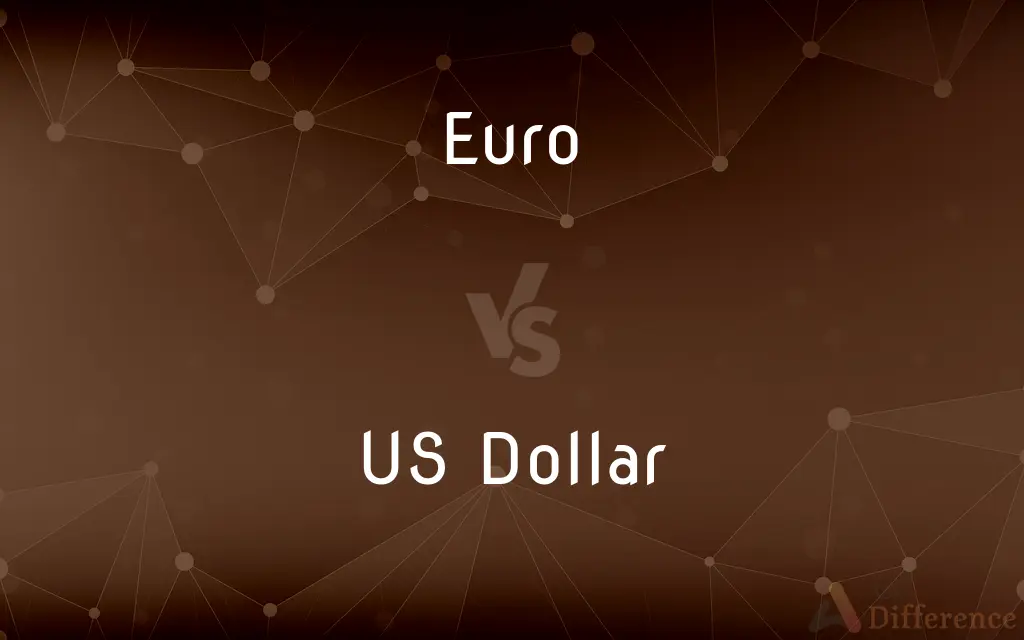Euro vs. US Dollar — What's the Difference?
By Tayyaba Rehman & Fiza Rafique — Published on February 15, 2024
The Euro (€) is the currency used by many EU countries, while the US Dollar ($) is the currency of the United States, reflecting different economic zones.

Difference Between Euro and US Dollar
Table of Contents
ADVERTISEMENT
Key Differences
The Euro and the US Dollar serve as the official currencies of different economic regions. The Euro (€) is used by 19 of the 27 European Union countries, known collectively as the Eurozone. The US Dollar ($), on the other hand, is the currency of the United States and is one of the world's primary reserve currencies. This distinction underscores the Euro's role in facilitating trade and economic policy within Europe, while the US Dollar serves as a global financial standard.
In terms of value, the Euro and the US Dollar fluctuate based on market conditions. The Euro's value is determined by the economic performances and policies of the Eurozone countries, as well as the European Central Bank's monetary policy. The US Dollar's value is influenced by the United States' economic conditions, federal interest rates, and fiscal policies. The exchange rate between the Euro and the US Dollar is a critical economic indicator, reflecting the relative health of their respective economies.
The Euro and the US Dollar also differ in their historical contexts and purposes. The Euro was introduced in 1999 with the aim of promoting economic integration and stability in Europe. The US Dollar, established as the United States' currency in 1792, has long been a cornerstone of international trade and finance. These origins highlight the Euro's role in European unification efforts, whereas the US Dollar underscores its global dominance in finance and trade.
Security features and design elements of the Euro and the US Dollar reflect their cultural and economic significance. Euro banknotes and coins feature designs that represent European unity and diversity, with no real-world landmarks to avoid favoring any member state. US Dollar bills, however, showcase prominent American figures and symbols, emphasizing the nation's history and cultural heritage. These design choices symbolize the Euro's commitment to European integration and the US Dollar's representation of American identity.
Finally, the global acceptance of the Euro and the US Dollar illustrates their international roles. The Euro is widely used across Europe and in international markets as a major currency. The US Dollar, however, is accepted worldwide, serving as the primary currency for international transactions and as a benchmark in the global financial system. This global acceptance underscores the US Dollar's role as a key currency in world economics and the Euro's significance within Europe and beyond.
ADVERTISEMENT
Comparison Chart
Symbol
€
$
Usage
Official currency in 19 EU countries
Official currency of the United States
Introduction
1999 (physical coins and banknotes)
1792
Economic Zone
Eurozone (European Union members)
United States and its territories
Global Acceptance
Widely accepted in Europe, recognized globally
Universally accepted and used worldwide
Reserve Status
One of the world's leading reserve currencies
The world's primary reserve currency
Design Elements
Features architectural styles, no real landmarks
Features American presidents and symbols
Inflation Rate
Managed by the European Central Bank
Managed by the Federal Reserve
Exchange Rate Stability
Influenced by EU policies and economic conditions
Influenced by US economic policies and global demand
Compare with Definitions
Euro
The Euro is represented by the symbol €.
The souvenir was priced at 20€.
US Dollar
The US Dollar is symbolized by the dollar sign ($).
The total cost was $30.
Euro
A unit of currency used for most transactions in Eurozone countries.
I exchanged my dollars for Euros before my trip to Italy.
US Dollar
It is the world's leading reserve currency.
Central banks hold significant reserves in US Dollars.
Euro
It serves as one of the world's major reserve currencies.
The bank offers accounts denominated in Euros.
US Dollar
The US Dollar is the official currency of the United States.
The price tag showed 50 US Dollars.
Euro
The Euro is the official currency of the Eurozone, a monetary union of EU countries.
Prices in France are listed in Euros.
US Dollar
The US Dollar serves as a benchmark for global economic transactions.
The exchange rate was favorable against the US Dollar.
Euro
The Euro aims to facilitate economic stability and integration in Europe.
The Euro has made cross-border travel and trade easier within Europe.
US Dollar
A primary currency used in international trade and finance.
Oil prices are often quoted in US Dollars.
Euro
The currency unit of the European Monetary Union. Symbol: €
Euro
A coin with a face value of one euro.
Euro
Abbreviation of Europeanin any sense.
Euro size
Euro style pad
Euro
Macropus robustus, a wallaroo (macropod species).
Euro
The basic monetary unit of most members of the European Union (introduced in 1999); in 2002 twelve European nations (Germany, France, Belgium, Luxembourg, the Netherlands, Italy, Spain, Portugal, Ireland, Greece, Austria, Finland) adopted the euro as their basic unit of money and abandoned their traditional currencies
Common Curiosities
What is the Euro?
The Euro (€) is the currency used by many countries in the European Union.
What symbolizes the Euro?
The Euro is symbolized by €.
Who manages the US Dollar?
The Federal Reserve, the central bank of the U.S., manages the Dollar.
What symbolizes the US Dollar?
The US Dollar is represented by the $ sign.
How do the Euro and US Dollar compare in value?
Their value fluctuates based on market conditions and economic policies.
Can the Euro be used outside of Europe?
Yes, the Euro is widely accepted in many countries outside of Europe, especially in tourist areas and for international transactions.
What roles do the Euro and US Dollar play in global finance?
Both serve as major reserve currencies, but the US Dollar is the primary reserve currency worldwide.
Is the US Dollar accepted worldwide?
Yes, the US Dollar is one of the most universally accepted currencies.
What is the US Dollar?
The US Dollar ($) is the currency of the United States, used both domestically and internationally.
What are the main differences in the design of Euro and US Dollar banknotes?
Euro banknotes showcase European architectural styles without specific landmarks, while US Dollar bills feature prominent American figures and symbols.
How does the exchange rate between the Euro and US Dollar affect global economics?
It influences international trade, investment, and economic stability.
Can inflation rates affect the value of the Euro and US Dollar?
Yes, inflation rates directly impact the purchasing power and international value of both currencies.
Who manages the Euro?
The European Central Bank (ECB) is responsible for the Euro's monetary policy.
How do the Euro and US Dollar influence international travel?
They determine spending power abroad and are crucial for budgeting in different countries.
Why was the Euro introduced?
The Euro was introduced to facilitate easier trade and economic stability among EU member states.
Share Your Discovery

Previous Comparison
Overweight vs. Obese
Next Comparison
Fluorescent Bulbs vs. Incandescent BulbsAuthor Spotlight
Written by
Tayyaba RehmanTayyaba Rehman is a distinguished writer, currently serving as a primary contributor to askdifference.com. As a researcher in semantics and etymology, Tayyaba's passion for the complexity of languages and their distinctions has found a perfect home on the platform. Tayyaba delves into the intricacies of language, distinguishing between commonly confused words and phrases, thereby providing clarity for readers worldwide.
Co-written by
Fiza RafiqueFiza Rafique is a skilled content writer at AskDifference.com, where she meticulously refines and enhances written pieces. Drawing from her vast editorial expertise, Fiza ensures clarity, accuracy, and precision in every article. Passionate about language, she continually seeks to elevate the quality of content for readers worldwide.













































